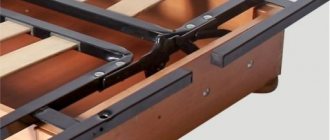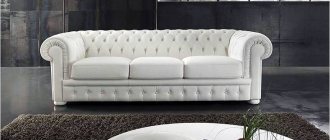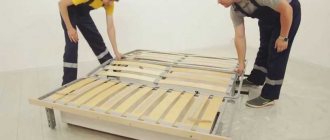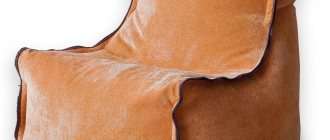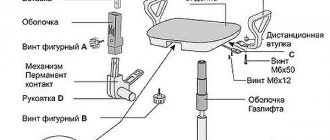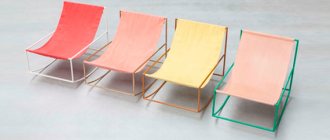How to reupholster a sofa with your own hands step by step
It always brings joy when we buy something new for our home, such as furniture. Every apartment or house must have armchairs, a sofa, ottomans, and chairs. We use them all the time.
It's hard to imagine an apartment without a sofa, armchairs and other upholstered furniture.
Time passes, the upholstery becomes ugly, wears off in places, holes, stains, traces of paint, felt-tip pens, and plasticine stuck in places appear. All this remains, especially when there are small children in the house. They will take furniture to the extreme in just a few months. The stains cannot be cleaned, the holes cannot be mended, even a bedspread will not save you from their pranks, except perhaps a Euro-cover. The furniture becomes unusable and ceases to decorate the interior.
After a few years, the upholstery may lose its former attractiveness, become unusable and no longer fit into the interior of the room.
Many people simply get rid of it, throw it in a landfill or take it to their country house. Others, on the contrary, cannot get rid of old furniture simply because it is comfortable or it is a pity to throw it away, and it is simply not possible to buy a new sofa or chair. What to do in such cases? There is only one thing left - to restore and reupholster the sofa. Of course, you can turn to specialists, but it’s easier and much more profitable, in order to save your budget, to do it yourself.
Not everyone knows that reupholstering a sofa with your own hands is not a very difficult task.
The benefits of making it yourself
It’s a big plus if the sofa has a high-quality base. Old pieces of furniture are much better quality than those that are produced now.
Replacing the upholstery will not take much time and effort.
Restoring furniture at home has several benefits.
- You reupholster the sofa with any material you like, and you can add picturesque elements to your liking.
- When performing work to replace the upholstery, you can repair the frame or spring unit if necessary.
- Outdated sofas, as a rule, are the strongest and best quality, prevailing in all properties over modern furniture.
- By doing this work yourself, you won’t spend a lot of money, but a new sofa or chair will cost much more.
- You don’t have to throw your favorite soft corner into a landfill because it has become unusable.
It’s worth deciding whether you will reupholster the sofa yourself, in which case the work will take more time, or trust the specialists, they will do it in a short period, perhaps at your home, without transporting it to a workshop.
We reupholster the car interior with leather ourselves
Sooner or later, the car owner begins to wonder: shouldn’t the interior of his “iron horse” be reupholstered with leather? The reason for these thoughts can be anything. For example, the car is already old and the standard interior covering has become unusable. Or the car got into an accident and the airbags deployed, destroying half of the dashboard. The reason is not so important, the answer to the question is important: is it possible to reupholster the interior yourself? Can! Let's try to figure out how to make a tight fit correctly.
Deciding on the design
To change the appearance of an old sofa, you can sew a new cover, make pillows and throws of various models. The furniture will sparkle with new colors. If reupholstery is required, it can be done partially by replacing some upholstery elements. There are many varieties here - from typical to creative.
It is important that everything is in harmony.
A cape made using the patchwork technique will look extraordinary. You can make an unusual applique and glue it to the upholstery. Denim or faux leather is suitable for upholstering a sofa. The most commonly used furniture tapestry, high-quality leatherette, leather, special synthetic velor, artificial fur with a strong base, and furniture jacquard. It is quite possible to sew removable covers from clothing fabrics.
If the sofa is not intended for decoration, but for relaxation of all family members, then you will need strong upholstery that will last for quite a long time.
Necessary materials
To begin work on replacing old upholstery, the first thing you need to decide is what fabric you choose, color scheme, with or without a pattern, artificial or natural material. There are many different furniture fabrics.
Each fabric has technologically advanced and multifunctional quality levels.
Let's decide what materials will be needed. In addition to the fabric itself, you need fittings, foam rubber of the required thickness, piping to cover the seams, felt, padding polyester or batting as a filler, a zipper, marker needles, decorative buttons.
Required Tools
We have chosen the fabric - it must be taken with a margin for the possibility of error, now we will prepare the tools that will be needed: a sewing machine, a set of needles, strong threads (polyester), a flat-head screwdriver, a hammer, an anti-stapler to remove old staples, pliers, wrenches (from 8 up to 19 mm), side cutters, furniture stapler, scissors, staples (6-8 mm), sewing meter, square, metal ruler, chalk, screwdriver, drill, glue.
The necessary set of tools.
The reupholstering process: step-by-step instructions
All work is divided into stages. First you need to disassemble the furniture. We remove all pillows, cushions, and decorations. Then, using the necessary tools, we separate the back and sides of the sofa.
Disassembly with removal of individual components in the form of pillows, sides, poufs.
We dismantle the seat and separate the furniture from the base. The parts needed for fastening need to be placed in some container; they may be needed.
All fasteners are placed together so as not to lose them.
The next step is to remove the worn upholstery using an anti-staple gun or a flat-head screwdriver. You can leave the old fabric - it will be easier to cut out patterns from it. We remove dirt and dust accumulated inside. Old foam rubber should be thrown away and replaced with new one.
The work requires a certain amount of care so as not to tear the old covering and use it as a template for cutting out parts from new fabric.
Let's look at the condition of the spring block and frame. If necessary, we carry out repairs. We strengthen all the joints and tighten the screws.
All screws must be carefully tightened, the joints of the parts must be strengthened, and the wooden joints must be glued.
Using the old fabric, we cut out new patterns from the selected material, leaving seam allowances. We fasten the parts with special needles and stitch them on a sewing machine. If you don't know how to sew, entrust the work to a seamstress.
The result of the entire reupholstery of the product largely depends on the quality of the new patterns.
Now you need to cover the sofa. We attach new upholstery to each individual part, starting with the decorative elements, then the seat, sides, and back. We carry out the tension carefully so that there is no distortion, using a stapler in the work.
In order not to make a mistake with the amount of material, it is recommended to buy it with a small margin.
The fabric on the sofa parts is stretched evenly so that there are no distortions.
Four centimeters - this should be the gap between the staples. Use the remaining material at your discretion. We attach the foam rubber, and its remains will be useful for upholstering other furniture.
Having finished with the reupholstery, we assemble the structure and return the legs and other fittings to their place.
Do-it-yourself car interior trim: some useful tips for each part of the interior
First, let's watch the video:
Seats
If you are planning to completely replace the upholstery on the seats, and not purchase new covers, then first you need to cut the old upholstery at the seams, and you will use it to make a pattern. After the individual elements are ready, use a sewing machine to assemble them into a single product. Nowadays it is much easier to go and buy new covers; car stores have a huge selection of different options for this product.
Doors
Removing dirt is especially important when changing the upholstery on car doors yourself. When you start cutting, remember to leave about a centimeter allowance on all sides of the piece. Be careful when making the holes needed for the door handle and window crank. In places where the upholstery is adjacent to the door, be sure to apply a layer of glue.
Do-it-yourself car interior reupholstery: ceiling
To replace the ceiling lining, an important fact is the complete dismantling of all backlight lamps, plugs, handles and decorative parts of the racks. Only fulfilling this condition will allow you to change the ceiling trim as carefully as possible. By the way, if you have chosen leatherette for the ceiling, it is recommended to heat it up a little before installation, then it will be elastic, which means it can be fixed easily and simply.
Armrests
To reupholster the armrests, you first need to remove them, then make patterns using the previous parts, making sure to leave small reserves of material around the edges. After this, the product is glued over the entire area, the edges are carefully secured, and processed using a hairdryer.
And finally
In cases where there is a need or simply a desire, before the final installation of the new upholstery, foam rubber or special insulating material is placed under the parts.
As it becomes clear from all of the above, reupholstering the car interior with your own hands is a very real task. Of course, it requires investing a certain amount of money and several hours of time, but the result is worth it, because then you will be proud that you changed all the upholstery in your car with your own hands, without the help of professionals.
Source
How to cover a sofa with your own hands?
The most significant point in this work is purchasing the required amount of fabric. You can roughly calculate how much you need by adding the length and width of the sofa and multiplying the resulting amount by two. For example, a sofa has a size of 2 x 1.8, then you will need to buy 7.6 m of fabric. To find out exactly, draw the layout of the necessary elements, taking into account the fractional direction. You need to be extremely careful when making calculations for corner sofas, because they have a complex shape.
When choosing fabric, you should avoid synthetic and very coarse varieties.
It must be remembered that material with a large pattern or stripes must be cut in one direction; accordingly, fabric costs will increase. It is very important to consider seam allowances. You definitely can't go wrong if you buy upholstery fabric with a one-meter margin. It is worth considering the fact that you will need to change the filler. Compacted foam rubber and a layer of padding polyester are quite suitable for this purpose.
It is recommended that instead of 50 mm thick foam rubber, use 2 sheets of 20 mm each, with a layer of felt between them.
The structure of some pieces of furniture may include parts filled with thick foam rubber. This causes certain difficulties. To avoid this, foam rubber is wrapped in thin padding polyester, then attached and wrapped in upholstery fabric.
High-quality foam rubber has very small pores in its structure. After squeezing with your hand, it immediately straightens and takes its previous shape.
How to reupholster a sofa with your own hands correctly and avoid mistakes when sewing parts? It will be better if you familiarize yourself with master classes, watch video and photo lessons, and read the necessary information on the Internet.
This will help you quickly and thoroughly complete the necessary work and assemble the parts correctly.
Some features of the banner
The main nuance in high-quality reupholstery of any sofa is the fastening of the upholstery. The material should not be too stretched, but there is no need to give the fabric too much freedom. Press the fabric with your hand - on a properly re-upholstered sofa this can be done without much effort, after which the material and filler should return to their original state. If you hear creaks or cracks in the upholstery, it means the tension is excessive and over time the upholstery will tear.
Note! The upholstery of corner sofas and furniture with springs also has its own characteristics, more on them later.
Corner sofa
The main condition when working with such a design is the combination of the pattern. You need to start marking the upholstery from one of the edges, moving towards the opposite. The sequence is as follows: first we sheathe the corner, then the sleeping area, and only then the backrest.
Reupholstering a corner sofa should start from the corner.
Spring sofa
When upholstering a spring sofa, an additional layer of material is most often used between the upholstery and the metal frame. This is to reduce the risk of the upholstery tearing at the sides where the soft padding layer does not fit.
When working with a spring sofa, an additional layer of material is used.
The nuances of working with genuine leather
When using genuine leather as upholstery, several rules are followed. Firstly, the thickness of the material should not exceed 1.5mm. Such leather remains elastic for a long period of time and does not crack in places where it is bent.
Important! It is strictly forbidden to upholster furniture yourself with damp leather, because when the moisture evaporates, the material will shrink.
When cutting leather, you should not use pins and needles to secure the material in any place except the seams, because holes in the leather will not be closed. When stitching leather, lubricate the sewing machine foot with Vaseline, this will speed up the stitching process and protect the material from tearing.
When upholstering a sofa with genuine leather, you should be as careful as possible.
The material left for allowance may pill when stretched. To avoid this, we iron such places with an iron through gauze - and the problem is solved.
After studying all the stages of the process of reupholstering a sofa according to our instructions, all that remains is to be patient and you can begin repairing upholstered furniture at home with your own hands. Even the most bulky sofa can be restored to its former luster in just one or two days of work.
The final stage is decoration
The sofa is the most important piece of furniture. We gather there with the whole family, relax after work, watch TV, and sometimes it’s just great to lie around, covered with a cozy blanket. Its color scheme is significant in the design of a room.
How to make an old sofa sparkle with new colors?
To begin with, you can change the area around the furniture, for example, change the wallpaper or stick photo wallpaper. Picturesque prints will look original. They decorate pillows - choose some image and apply it to the cover. This is best done in a workshop.
You can sew stripes or squares yourself, using fabrics of different colors, or combine them.
The most ideal option is to replace the cover. If you don't want to sew it yourself, buy it at the store. Now there is a very large selection of different colors and models. They have different features, including water-repellent, and even ones that are resistant to the sharp claws of your pets. Well, the simplest option is to cover the sofa with a blanket or two.
This will create a cozy atmosphere that sets you up for relaxation.
Pillows with new covers of different colors will add some zest to the sofa. Saturated shades are best placed in the center, neutral shades are preferable at the edges. If you like a style such as eclecticism, then feel free to use all your imagination - combine incompatible things. Sofa cushions can be square, round or triangular, large and small, of different colors, different fabrics, even fur.
The color of the pillows can be matched to the curtains, lampshade, and chair.
Reupholstering furniture is a fun activity that does not present any particular difficulties. The main thing is to do everything according to the rules, and you will have original old furniture at home that will serve for many years to come.
Peculiarities
You can reupholster a sofa of any shape and size, and this work can be done either independently or with the help of specialists in a furniture workshop. If you perform the reupholstery yourself, it is worth remembering that such a process has some features that you will definitely have to encounter during the work.
First of all, you will have to independently take care of choosing and purchasing not only suitable material, but also a sufficient quantity of it. So, for a leather sofa, it is better to purchase eco-leather rather than genuine leather as an upholstery material, and the material should always be taken with a reserve.
Not only the appearance of the restored furniture, but also its subsequent service life will depend on the correct choice of fabric.
It is imperative to take into account the design features of a particular furniture model. Some sofas have a rather complex shape and cannot be completely disassembled when replacing the upholstery, so you will have to try to ensure that in such places the fabric completely follows the shape of the sofa itself. So, when reupholstering a corner sofa, you need to pay special attention to the degree of tension of the fabric at the corners and joints of the parts of the frame of this furniture. There may be some difficulties in performing this work without the proper skills.
The second feature is that if the furniture is too old and not only the upholstery fabric itself has worn out, when reupholstering it will be necessary to replace not only the material, but also part of the filling in the furniture, and possibly some parts of the frame.
This should be taken care of in advance.
By reupholstering sofas at home, you can not only extend the life of the furniture itself, but also visually change its appearance, and with it the room itself. After all, many people know that the overall tone of the interior style of a room is set by the furniture that is located in it. Therefore, the restoration process itself must be approached very seriously. During the work itself, you should not rush and be distracted by foreign objects. It is best to do the sheathing at a time when no one and nothing can disturb you.
You need to be prepared in advance for the fact that the work itself, especially when done for the first time, will take quite a lot of your time and effort.
By and large, you can upholster any sofa at home with your own hands, regardless of its size. The main thing is to stock up on all the necessary materials and tools in advance, carefully study the instructions for performing this work and be ready to follow them completely. If such work seems quite labor-intensive, then you can practice on a chair or armchair, or even entrust the upholstery to specialists.
Material selection
In any case, regardless of whether the work of reupholstery is carried out independently or by specialists, the first thing you will have to face is the choice of a suitable material. Experienced professionals recommend using the following tips in this case:
- is imperative to change the soft filling of the sofa , and not just its upper fabric. If padding polyester is used as a filler, then preference should be given to one that has a pure white color, as this is evidence of its high quality. If the filler is foam rubber, then you need to use two sheets of it, 2 cm thick, and lay a sheet of felt between them.
- For the upper upholstery material, it is better to choose a dense fabric that has a small pattern without large or voluminous prints. This will allow you to save on material, because pieces of it will not fall back due to a mismatch in the pattern. In addition, as practice shows, such sofas get dirty less and retain their appearance better during use.
- It is better to give preference to fabrics that do not have lint, for example, leatherette . If there are villi, you need to ensure that they are short and of the same length. Please note that the fabric does not have a sharp and strong unpleasant synthetic aroma. If it exists, then this indicates low quality and its unsuitability as a fabric for furniture restoration.
- It is better to abandon too rough materials and replace them with eco-leather or tapestry, which will give the furniture a refined, beautiful and stylish appearance. The word “rough” means fabric that is unpleasant to the touch and has an unpresentable appearance. Using such material, you can not update your furniture, but, on the contrary, artificially age it even more.
- It is worth remembering that natural cotton materials wrinkle too quickly and when used during stretching, they lose their original appearance, so it is best to discard them. Otherwise, after a few months of regular use of the sofa, it may again require restoration.
- Jacquard fabric fits perfectly , it is quite dense, wear-resistant, has an attractive appearance and is sold in various color variations. But it is still better to give preference to jacquard in dark tones and without bright color accents on the fabric. They are the first to wear out and spoil the entire appearance of the upholstery.
- Flock and velor have a beautiful appearance and are quite pleasant to the touch, but they quickly wear out and lose their attractiveness, so the use of such fabrics is also extremely undesirable.
- A material such as chenille has good wear-resistant properties, is attractive in appearance and is perfectly cleaned of any dirt, so it is recommended to be used as a material for upholstering sofas.
- Arpatek may well become a worthy replacement for genuine leather or eco-leather, as it has the same characteristics as them, but at a lower cost.
As the main material for upholstering sofas, you should choose dense, lint-free fabric with a fine pattern, or plain materials that have high wear resistance. Only such fabrics make sense to choose, because they will allow you to use the updated sofa for a very long time.
I would also like to note that if the sofa has wheels or legs, they should also be replaced with new ones while re-upholstery is being carried out. This will completely refresh the appearance of the sofa and improve its stability.
Required tools and materials
If you have already decided on the material in which you will reupholster the interior, it’s time to calculate its approximate volume. In total you may need from 6 to 25 meters. But these figures are very approximate: it all depends on the specific car model. So, a crossover or SUV will require much more material than a coupe car. Therefore, do not be lazy and measure the length of the ceiling, the length of the cushions and backrests, the size of the front panel, as well as the width and height of the car doors. Add up all the resulting numbers and add at least a meter as an error. Believe me, you will need it.
In addition to the material itself, you will need other tools:
A set of screwdrivers with straight and Phillips slots for dismantling some elements;
Separately, I would like to dwell on the choice of glue. Do not use Moment glue or other similar superglues. Universal glue 88 is often used for reupholstering, but it also has a number of disadvantages. Buy quality glue that can withstand high temperatures. MAH is well suited for these purposes. Its price is quite high, but if you don’t want to see the coating swell and come off after just a few months, spend money on it.
Use high temperature adhesive to bond leather to plastic parts.
Preparatory stage
Once the required material has been selected, you can proceed to the first stage of upholstering the sofa, which consists of creating a pattern from the fabric. This stage should be given special attention, because the result of the entire final work will depend on the quality of its implementation. In this case, the pattern can be made in two different ways:
- Make a pattern based on the old upholstery , which was previously removed from the sofa. In this case, the removed upholstery is applied to the purchased fabric and traced along the contour. Be sure to leave an overlap of a few centimeters - 5 will be enough. Subsequently, the resulting pattern is applied to the furniture frame and if it matches its contours, it is cut out.
- The second option is more labor-intensive. First, all parts that can be removed are removed from the sofa - armrests, backrests and pillows, carefully measured with a tape measure on all sides, and the results obtained are transferred to the fabric, taking into account the addition of 5 cm on each side. Subsequently, all parts of the pattern are cut out and applied to suitable places on the sofa . If everything is in order and the pattern pieces are the required size, you can proceed to further steps.
When creating a pattern using any of the methods described above, experts recommend double-checking the measurements taken correctly before cutting the pattern from the fabric. It is in this situation that the proverb “measure twice, cut once” is more relevant than ever.
Do-it-yourself car interior reupholstery with leather, technology
Now that everything is prepared, you can get to work. First you need to dismantle the element with which you are supposed to work. After which the process will look like this:
- Apply masking tape to the part, consider the seam locations and patterns
- Mark the seams with a pen and carefully cut out with a stationery knife, stick the patterns from tape onto pieces of clean paper, cut them along the contour
- Transfer the shape of the elements to the skin and cut out pieces with a margin for the seam
- Sew a cover
- Try on and adjust if necessary
- Degrease the surface
- Gradually applying glue to both surfaces, pull the cover onto the part, smoothing it with your hands and drying it with a hairdryer.
- Let dry for about a day
- Install a new part
Watch a video on how to reupholster a car interior with leather.
Notes on reupholstering a car interior with leather yourself
The technology above is indicated for complex, often plastic, parts. For seats, the technology will be different in that there is no need to use glue; the new seat cover is attached using ropes, wire, a construction stapler and other methods. If the element is simple and does not have large bends, then there is no need to prepare patterns, and the fitting should be done in one piece, and it should first be soaked in warm water for about 3 hours, and then, after applying it to the part, stretch it, drying it with a hairdryer. To work with moving, built-in elements (ashtray, glove compartment), you need to remember that covered elements increase in size and may begin to get stuck.
Required Tools
In order to reupholster a sofa at home, as well as to complete its preparatory stage - creating a pattern, you may need the following tools:
- The material of the upholstery itself.
- Filler material.
- Scissors.
- Chalk or bar of soap.
- Stapler and staples for it.
- Safety pins.
- Sewing machine or just thread and needles.
- Extra strong threads.
- Screwdriver.
- Pliers.
- Pliers.
- Tape measure or regular measuring tape.
Depending on the type of sofa, you may also need a glue gun, medium-thick felt, a spring block, a screwdriver and self-tapping screws. The number of tools always directly depends on the exact model, shape and dimensions of the sofa chosen for restoration.
If everything is clear with the material, scissors and chalk, then pliers and a screwdriver, as well as pliers, can be used to unscrew some parts of the sofa when directly pulling the material. Not in all cases it may be necessary to use all of the above tools, but just in case, it is better to prepare everything in advance rather than then run around the apartment looking for a suitable tool.
DIY reupholstery process
Reupholstering the interior yourself is a painstaking task that can take you more than one day. All work can be divided into several stages:
In order for the work to go faster and better, you should follow several general rules that apply to both large parts with complex shapes and smaller elements of the car.
When cutting material, be economical. Remember school labor lessons and crafts made from colored paper. You need to arrange the parts patterns so that there is as little empty space between them as possible. This will reduce the amount of trimming.
Now let's look at the reupholstery of each element of the car in more detail.
How to do it yourself?
Upholstering a sofa at home is not such a complicated process. If this procedure is performed for the first time, then, of course, some difficulties may arise. In order to avoid them and upholster your favorite sofa yourself as simply and quickly as possible, we will tell you step by step how to reupholster two types of sofas - regular and corner.
Straight without springs
You should begin work by dismantling individual components of the sofa, such as corners, pouf, backrests and pillows:
- If necessary, use a screwdriver or pliers. The main thing is to dismantle it very carefully so as not to damage all parts of the sofa. It is best to put them together in sequence of removal.
- Next, the old upholstery is removed from the sofa body and the removed parts. This process is quite labor-intensive and requires extreme care, because the removed material can later be used as a basis for a pattern. It must be laid out on a flat horizontal surface to level it. This will help you take measurements more accurately in the future and create a pattern correctly.
- After removing the fabric the inside of the sofa is cleaned , dust, debris and pieces of stuffing are removed. Now, if necessary, you should remove all the packing and replace it with a new one, or simply adjust it and give it the correct position.
- The next stage is creating a pattern. How to do it correctly was described in detail above, so we will not describe this process again.
- Now you need to the cut parts directly to the sofa. This work should be done step by step and carefully. The material itself should be stretched as evenly as possible so that the pattern does not sag and, as a result, the sofa looks like new. It is best to start reupholstering from the back, sides and seat of the sofa.
- After the upholstery has been replaced, you can begin to directly re-tighten the frame of the sofa itself. The fabric is attached using needles and threads to the removable parts and using a stapler to the frame. You can also use a standard glue gun.
- Now you need to reassemble the sofa in the reverse order of dismantling it. If there are pieces of fabric left, they can be used to reupholster ottomans or decorate the backs or armrests of the sofa itself. The decor, of course, should be selected independently, in accordance with the overall interior of the room and the style of the furniture itself.
Corner with spring mechanism
The corner sofa itself has a more complex design, and the level of complexity of the upcoming work of replacing the upholstery is also increased by the existing springs. Therefore, I would like to immediately say that covering a spring sofa will be more time-consuming and troublesome compared to the restoration of a simple model that does not have spring blocks. In any case, the process of pulling a sofa can be divided into the following stages:
- Disassembling the sofa into two components. Here it is necessary to separate the corner parts from each other. If this step is performed correctly, you should end up with a free-standing small sofa and a corner chair.
- Now you need to remove all the components that can be dismantled yourself.
- Next, we remove all the padding from them and do the same with the material on the frame of the sofa itself.
- We remove the filler and take out the spring block itself, which is attached to the bottom of the sofa using twine, which must be carefully cut. If the springs are intact, then we carefully straighten them and install them in place; if not, then we go to a hardware or furniture store and buy new ones.
- It is necessary to intertwine all the springs with each other using very strong linen or cotton threads.
- We make a pattern from the removed stuffing, carefully roll it up and place it on top of the springs, lay the filler on top, new or previously cleaned of existing contaminants.
- Now we cut out the resulting patterns and cover the removable parts of the sofa with new upholstery, then its frame. As in the previous case, you should carefully monitor the uniform tension of the material on the parts of the sofa.
- After all parts of the furniture have been re-stretched, you first need to assemble the sofa, that is, connect the sofa itself and the corner chair, and only then install its removable parts.
Using a similar scheme, you can restore almost any model of sofas with spring blocks. The main thing is to carefully follow the instructions and complete all stages of the work slowly.
Subject of the privacy policy
3.1. This Privacy Policy establishes the Administration’s obligations to non-disclose and ensure a regime for protecting the confidentiality of personal data that the User provides at the Administration’s request when registering on the website of the Online Store of Creative Materials, when subscribing to an e-mail newsletter or when placing an order.
3.2. Personal data permitted for processing under this Privacy Policy is provided by the User by filling out forms on the website of the Online Store of Creative Materials and includes the following information: 3.2.1. last name, first name, patronymic of the User; 3.2.2. User's contact phone number; 3.2.3. email address (e-mail) 3.2.4. place of residence of the User (if necessary) 3.2.5. delivery address of the Product (if necessary) 3.2.6. photograph (if necessary).
3.3. Studio Elena protects Data that is automatically transmitted when visiting pages: - IP address; — information from cookies; — information about the browser — access time; — referrer (address of the previous page).
3.3.1. Disabling cookies may result in the inability to access parts of the site that require authorization.
3.3.2. Studio Elena collects statistics about the IP addresses of its visitors. This information is used to prevent, identify and resolve technical problems.
3.4. Any other personal information not specified above (visit history, browsers used, operating systems, etc.) is subject to secure storage and non-distribution, except for the cases provided for in paragraphs. 5.2. and 5.3. of this Privacy Policy.
